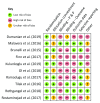Recent advances in understanding and managing phantom limb pain
- PMID: 31354940
- PMCID: PMC6652103
- DOI: 10.12688/f1000research.19355.1
Recent advances in understanding and managing phantom limb pain
Abstract
Post-amputation phantom limb pain (PLP) is highly prevalent and very difficult to treat. The high-prevalence, high-pain intensity levels, and decreased quality of life associated with PLP compel us to explore novel avenues to prevent, manage, and reverse this chronic pain condition. This narrative review focuses on recent advances in the treatment of PLP and reviews evidence of mechanism-based treatments from randomized controlled trials published over the past 5 years. We review recent evidence for the efficacy of targeted muscle reinnervation, repetitive transcranial magnetic stimulation, imaginal phantom limb exercises, mirror therapy, virtual and augmented reality, and eye movement desensitization and reprocessing therapy. The results indicate that not one of the above treatments is consistently better than a control condition. The challenge remains that there is little level 1 evidence of efficacy for PLP treatments and most treatment trials are underpowered (small sample sizes). The lack of efficacy likely speaks to the multiple mechanisms that contribute to PLP both between and within individuals who have sustained an amputation. Research approaches are called for to classify patients according to shared factors and evaluate treatment efficacy within classes. Subgroup analyses examining sex effects are recommended given the clear differences between males and females in pain mechanisms and outcomes. Use of novel data analytical approaches such as growth mixture modeling for multivariate latent classes may help to identify sub-clusters of patients with common outcome trajectories over time.
Keywords: assessment; central sensitization; cortical reorganization; neuropathic pain; phantom limb pain; referred pain; treatment.
Conflict of interest statement
No competing interests were disclosed.No competing interests were disclosed.No competing interests were disclosed.
Figures

References
-
- Richardson C, Glenn S, Nurmikko T, et al. : Incidence of phantom phenomena including phantom limb pain 6 months after major lower limb amputation in patients with peripheral vascular disease. Clin J Pain. 2006;22(4):353–8. 10.1097/01.ajp.0000177793.01415.bd - DOI - PubMed
Publication types
MeSH terms
LinkOut - more resources
Full Text Sources
Medical
Research Materials
Miscellaneous

